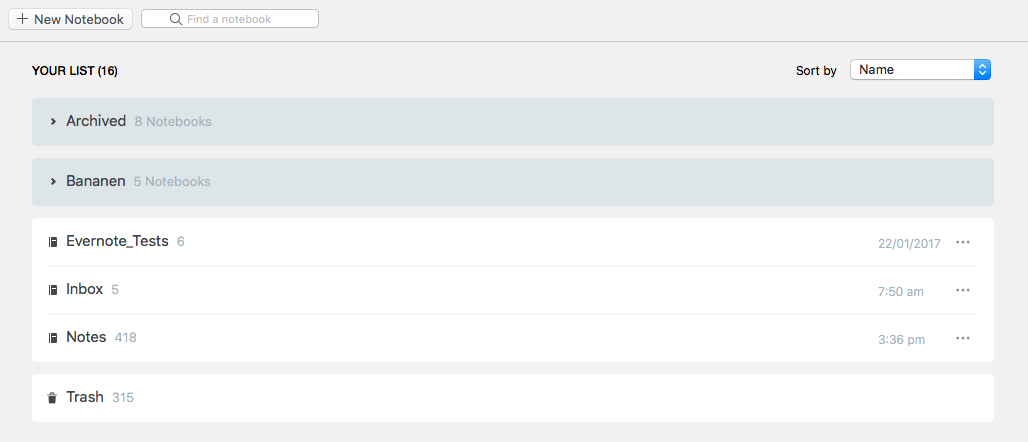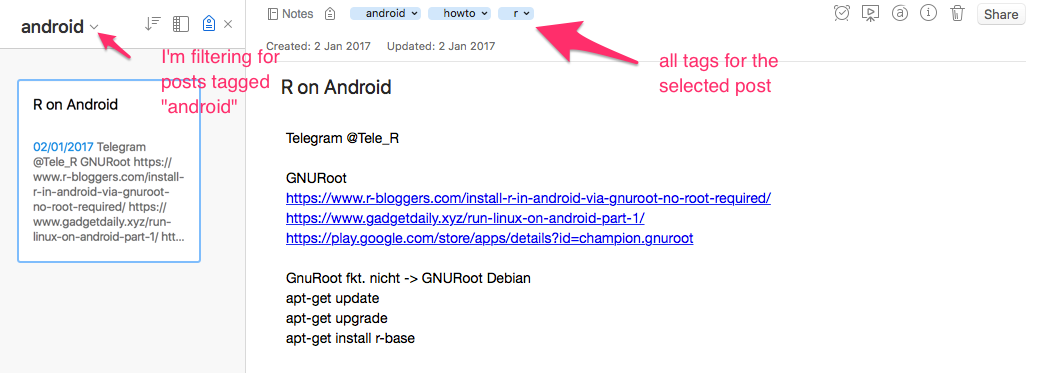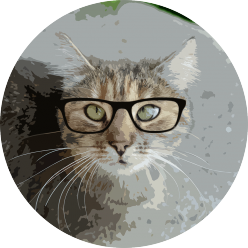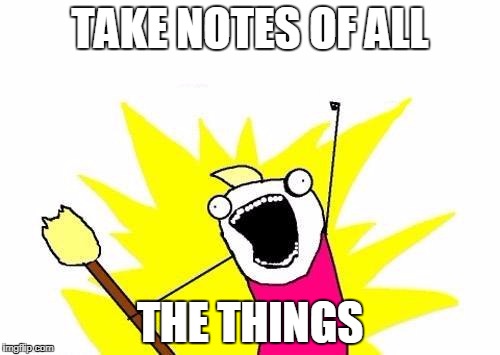I am a big fan of taking notes and having my thoughts and ideas organized and easily accessible.
After using mainly pen and paper for quite some time I started to look for a software solution. The main reasons were that I want to be able to search my notes and access them everywhere I am. After trying different tools which all have their pros and cons I stuck with Evernote which covers most of my note taking needs. This post will show you how I use Evernote and will be useful for you if you have similar tasks.
Disclaimer: I bought an Evernote Premium subscription myself and I did not receive anything for writing this blog post 🙂
Contents
Requirements for a note taking tool
To give you an idea of what I try to achieve with Evernote and if it can also be useful for you, I will shortly describe what my tasks are every day. Besides writing my blog, for which I need to collect ideas and resources, I work on different projects (coding, woodwork, …) for which I need to take notes or keep pictures.
Additionally I want to keep track of
- meeting notes
- scientific publications I read
- recipes I tried or found
- ideas for projects
Often I need to store a link to an article I would like to read and write myself reminders for upcoming tasks.
Going paperless?
Previously my desk has been full with Post-Its, notepads and sheets of paper with ideas, recipes, drawings, lecture notes and everything else I wrote down. I try to reduce this as much as possible, although I have given up on the idea that I can go paperless completely. Sometimes it is just more convenient and some notes (“Take out the trash!”, grocery lists, …) do not need to be digitalized.
Other tools I use(d)
I have tried several approaches and tools for achieving digitalisation of my thoughts. I went from using text files or Word Documents in combination with a cloud solution (owncloud, dropbox, Office 365) to different note/idea collection apps (wunderlist, pocket, trello, …). Each of them seemed interesting for a while, but either syncing didn’t work properly (I had issues with all of the mentioned cloud solutions), the app did not have everything I needed (wunderlist, pocket) or it was too complicated for my requirements (trello). I also used OneNote for a while, but the Mac client was horrible and it was missing critical features like moving a note to another notebook. Additionally I used Google Inbox for reminders and todos.
>> Love at first sight: Google Inbox.
Although Evernote has some things that could be improved (formatting, no templates, tables suck, no way to copy styles – like the brush in Word, …) after trying so many different tools, it was the best solution for my needs (and I am still happy with the decision!).
How I use Evernote
In the following section I am going to describe how I use certain Evernote features to organize my notes.
Tags
For a very long time I have been using lots of different notebooks (>40) with names like “Recipes”, “University”, “Travel”, “Meetings”, … for organizing my notes. The drawback with this approach is that each note can only be assigned to one notebook (should I put a meeting with my professor into “University” or “Meetings”?) and that notebooks can not be organized into more complex hierarchies (you can only put them on a stack). Instead of notebooks I now heavily rely on tags for grouping my notes. Instead of a notebook “Project” I know have the tags “project-idea”, “project-ongoing” and “project-finished” which are all children of the tag “project”. The advantage is, I can also add more specific tags to each project-node, e.g., the programming language I’m using (“r”, “python”) or anything else that is releated to the project (“arduino”, “android”, “mac osx”, …). Now I have only very few notebooks and mainly use “Inbox” (for notes that have to be tagged yet) and “Notes” for basically everything.


For more insights about how tags can be used, read this article.
Reminder
Most of my “todos” do not have a specific date, I just do not want to forget about them (such as articles I find online). I was using Google Inbox for a very long time and was happy with it, but it had some drawbacks. I hate the interface for picking the reminder time and you cannot really add information to a todo. In case anyone is wondering: I also do not like to use bookmarks in a browser because you cannot really mark a link as “to read” or “already read”.
The way I organize my todos now in Evernote is the following: Whenever I have something I need to be reminded about, I create a note and click the alarm clock symbol for adding a reminder. Optionally I add a date and time. Most of the time I add a tag “task-privat” (private tasks), “task-scientific” or “task-uni” (university related tasks), this makes it easier to filter todos. The main advantage with this approach is that I can add information to each todo. For example, if one of my tasks is to “Read paper X”, I can tick it as done when I am finished and collect my thoughts in the same note.
Emails
It took me some time to start forwarding mails to my Evernote account and I still use it rarely because it does not make sense for me to have mails duplicated in my mail account and in Evernote. But for some mails that contain a lot of information (e.g., a colleague sends me a howto or a list of useful links) I like to forward it to Evernote.
A very comprehensive article about sending mails to Evernote can be found here.
Link to notes
A feature that I use a lot is putting links to other related notes inside a note. One example can be seen in one of the figures above. Another example is how I organize the slides for a lecture I give. I have one note per slide set and an overview note in which I use links to create a table of contents.
I created the table of contents manually but there is also a functionality within Evernote to create a table of contents for selected notes.
Annotating images
Sometimes the annotate image tool (right click an image > Annotate this image…) is very useful for highlighting something on a screenshot or adding some text. Some examples can be seen in this blog post.
Using Evernote for meetings
Since I find Evernote rather useful for planning meetings and keeping meeting notes, I want to share my workflow with you. You will see that I actively use the features I mentioned above to stay organized.
Whenever a meeting is setup, I create a “Prepare XX meeting” note (replacing XX with the name or topic of the meeting). I add tags like “university”, “skype-call”, … to specify what kind of meeting it is. I immediately type some things that come to my mind that are relevant to the meeting (such as topics or single issues like “ask Alice about the paper she mentioned”). Later on I set a reminder shortly before the meeting (an hour, a day or a week, depending how much time I need to prepare). For preparing a meeting I send relevant emails to my Evernote account and link to them and other relevant notes inside the meeting note. After preparing the meeting, I change the reminder to the starting time of the meeting (so I do not have to look for the note during the meeting). During the meeting I add the date and the attendants. If I take notes during the meeting I add the tag “meeting-notes”. If there are things to be done after the meeting, I leave the reminder, otherwise I mark it as done.
This way I have everything related to this meeting in one note and not separate todos like I had before when using other todo-list apps. If a todo needs more work I can create a separate note, add tags and reminders and link to it in the meeting note, and so on.
That’s it!
In this post I tried to give you some insights in how I use Evernote and how you could be using it too. There is a lot more that could be mentioned but I tried to stick with the most important features. If you have any comments or suggestions how I could improve my workflow I would be happy to hear from you!


